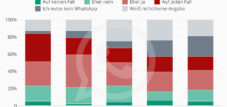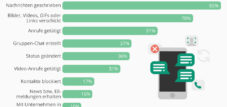WhatsApp data leak: Why 3.5 billion profiles were exposed for months – The biggest security failure in messenger history
Xpert pre-release
Language selection 📢
Published on: November 20, 2025 / Updated on: November 20, 2025 – Author: Konrad Wolfenstein

WhatsApp data leak: Why 3.5 billion profiles were exposed for months – The biggest security failure in messenger history – Image: Xpert.Digital
Data leak of the decade? Meta's risky silence: How a convenience feature betrayed almost all WhatsApp users
Not hacked, but exposed: Viennese researchers uncover a historical WhatsApp vulnerability.
What security researchers from the University of Vienna and the SBA Research Center have uncovered marks a turning point in the history of digital communications security. In a period of six months, between autumn 2024 and spring 2025, a small academic team succeeded in compiling virtually the entire global user directory of WhatsApp. The result is staggering: Over 3.5 billion accounts were identified, cataloged, and linked to sensitive metadata.
This wasn't a sophisticated hack involving firewalls or complex encryption. The "security vulnerability" was a deliberate design choice: the so-called "Contact Discovery" mechanism. This feature, intended to offer users the convenience of instantly seeing who else in their address book is using WhatsApp, became a gateway for data collection of unprecedented scale.
While Meta consistently emphasizes the inviolability of end-to-end encryption of message content, this incident vividly demonstrates that metadata often speaks an equally explosive language. From profile pictures that enable a global facial recognition database to the identification of users in repressive regimes, the implications of this incident extend far beyond the loss of phone numbers. Particularly alarming is the fact that the data query proceeded completely undisturbed for months via a simple, public interface, without the tech giant's security mechanisms intervening.
The following report analyzes the anatomy of this failure, highlights the economic and political risks for billions of users, and poses the question: How much privacy are we willing to sacrifice for a little digital convenience?
When convenience becomes a security vulnerability: Three billion profiles as collateral damage of network effects
The digital communication infrastructure of our time has revealed a fundamental vulnerability. What Viennese security researchers from the University of Vienna and the SBA Research Center documented between September 2024 and March 2025 surpasses all previous data leaks in its sheer scale. Over 3.5 billion WhatsApp accounts—virtually the entire global user directory of the world's most popular messenger—were effectively accessible without restriction. This is not a classic data breach in the conventional sense, where systems were hacked or passwords stolen, but rather a structural failure of a convenience feature that is taken for granted.
The so-called Contact Discovery Mechanism, that convenient automatic feature that immediately indicates whether a contact uses WhatsApp when a new phone number is saved, turned out to be a gateway for the most comprehensive user enumeration in digital history. Gabriel Gegenhuber and his team demonstrated that this function, which was actually designed as a user-friendly feature, operated without any significant security barriers. With a query rate of over 100 million phone numbers per hour, the researchers were able to systematically test the entire globally possible range of numbers without any intervention from WhatsApp's infrastructure.
What is remarkable about this process lies in its technical simplification. The researchers needed neither sophisticated hacking tools nor did they have to overcome security systems. Instead, they used a publicly documented interface intended for regular operation. All requests were routed through an IP address uniquely assigned to the University of Vienna, meaning that Meta could theoretically have detected the activity at any time. Despite comparing approximately 63 billion telephone numbers, no automated defense system intervened. Only after the researchers contacted Meta twice, and immediately before the planned scientific publication of the study, did Meta react with technical countermeasures in October 2025.
The Economics of Metadata: What Seemingly Harmless Information Reveals About Billions of People
Meta's initial reassurance strategy focused on the fact that no chat content had been compromised and that end-to-end encryption remained intact. However, this communication strategy falls short and systematically underestimates the value and significance of metadata. What the researchers were able to extract goes far beyond simple phone numbers and provides profound insights into global communication patterns, user behavior, and socio-technical structures.
The information accessed included not only the phone numbers themselves, but also public cryptographic keys necessary for end-to-end encryption, precise timestamps of account activity, and the number of devices linked to an account. Approximately 30 percent of all users had also included personal information in their profile text, often containing sensitive details about political beliefs, religious affiliation, sexual orientation, drug use, employer, or direct contact information such as email addresses. Particularly concerning is the fact that some of these addresses had governmental or military domain extensions such as .gov or .mil.
Around 57 percent of all WhatsApp users worldwide had their profile pictures publicly visible. In a sample from North America (country code +1), researchers downloaded 77 million profile pictures, representing a data volume of 3.8 terabytes. An automated facial recognition analysis identified human faces in approximately two-thirds of these images. This creates the technical possibility of linking faces to phone numbers, which has far-reaching implications for tracking, surveillance, and targeted attacks.
The aggregated analysis of the data also revealed macroeconomically relevant insights into global technology markets. The worldwide distribution between Android and iOS devices is 81 to 19 percent, which not only provides information about purchasing power and brand preferences but also offers strategic insights for competitors and investors. The researchers were able to quantify regional differences in data privacy behavior, such as which populations are more likely to use public profile pictures, and gain insights into user activity, account growth, and churn rates in different countries.
The findings on WhatsApp usage in countries with official bans are particularly revealing. In China, where the platform is officially prohibited, researchers nevertheless identified 2.3 million active accounts. In Iran, the number of users rose from 60 to 67 million, in Myanmar 1.6 million accounts were found, and even in North Korea, five active accounts were discovered. This information is not only relevant to technological policy but could also pose existential threats to users in repressive regimes if authoritarian regimes gain access to this data.
Cryptographic anomalies and the shadow economy of digital fraud
Another technically highly relevant finding concerns the reuse of cryptographic keys. Researchers discovered 2.3 million public keys associated with multiple devices or different phone numbers. While some of these anomalies can be explained by legitimate activities such as number changes or account transfers, striking patterns point to systematic abuse. Clusters of identical cryptographic keys across numerous accounts were found particularly in Myanmar and Nigeria, suggesting organized fraud networks with a division of labor.
These findings offer profound insights into the economics of digital crime. Romance scams, cryptocurrency fraud, and bogus support calls apparently operate using shared technical infrastructures, suggesting industrially organized fraud machinery. The efficiency gains achieved through shared identities and key infrastructures make these operations economically scalable. Furthermore, the reuse of keys poses significant security risks to the encryption itself, as misconfigurations or the use of unofficial clients could lead to de-anonymization, identity theft, or even the interception of messages.
Risk catalog: From personalized attacks to state repression
The immediate and indirect risks of this data leak far exceed the scope of typical security incidents. While traditional data breaches often remain confined to limited user cohorts, the universal enumeration creates an entirely new attack surface for criminal and state actors.
Personalized phishing and social engineering attacks are among the most obvious scenarios. The combination of phone number, profile picture, personal information in the info field, and linked email addresses or social media links enables highly individualized fraud attempts. While mass-distributed phishing emails are often recognizable by their generic wording, the information now available allows for spear-phishing campaigns that utilize personal details, real profile pictures, and context-specific information. According to studies, the success rate of such targeted attacks is over 40 percent, compared to just a few percent for standardized campaigns.
Identity theft and doxxing represent further serious threats. Linking facial images to phone numbers allows malicious actors to identify and track individuals in public spaces. Combined with other publicly available data sources, comprehensive profiles can be created that can be used for blackmail, harassment, or targeted discrediting. Particularly vulnerable groups, such as journalists, activists, minorities, or people in prominent positions, are at increased risk.
In countries with authoritarian regimes where WhatsApp is officially banned, identifying a user can have legal or even life-threatening consequences. The millions of documented users in China, Iran, or Myanmar could be subjected to systematic persecution if the state gains access to this data. Analyzing communication patterns, social networks, and movement profiles allows repressive regimes to map and preemptively dismantle opposition networks.
Stalking and systematic tracking are significantly facilitated by the combination of phone number, public profile, and technical metadata such as the number of devices and usage intensity. Timestamps of profile changes, information about device changes, and stable account IDs enable the creation of detailed behavioral profiles. Perpetrators of domestic violence, obsessive stalkers, or organized crime can use this information to monitor victims, analyze movement patterns, and identify points of access.
The widespread availability of valid, active phone numbers significantly boosts the scalability of spam and bot operations. While previous spam campaigns relied on purchased or randomly generated number lists, many of which are invalid or inactive, the data leak enables targeted messaging exclusively to active WhatsApp users. The additional device information also allows for the optimization of attack strategies based on platform and technical configuration.
Companies and organizations face specific compliance risks. Disclosing official telephone numbers, especially those of employees with access to sensitive information or systems, increases the attack surface for corporate espionage and targeted infiltration. Government domains in the .gov or .mil range indicate government employees, security personnel, or military personnel, who represent highly attractive targets for state-sponsored actors or organized crime.
The delayed response: Why it took Meta a year to act
The chronology of events raises fundamental questions about Meta's security culture and prioritization. The Viennese researchers discovered the vulnerability as early as autumn 2024 and first contacted Meta around the same time. A formal notification was submitted to the company's official bug bounty program in April 2025. However, effective technical countermeasures, such as rate limiting to prevent mass queries, were not implemented until October 2025, just before the planned scientific publication of the study results.
This time lag is problematic from several perspectives. First, it reveals weaknesses in the incident response management of a corporation that positions itself as a leader in security matters. The fact that billions of requests were made over months from an academic institution with a public IP address without any automated systems raising an alarm indicates insufficient monitoring capabilities.
Secondly, the question arises regarding the balancing of interests within the company. Rate limiting and stricter access restrictions can impair user-friendliness and potentially lead to complaints if legitimate use cases, such as adding many contacts simultaneously, are made more difficult. The long response time could indicate that product management decisions outweighed security concerns as long as there was no immediate public pressure.
Third, this episode highlights the effectiveness of bug bounty programs. Meta regularly emphasizes that it has one of the most generous programs in the industry, which distributed over four million dollars to researchers in 2025 alone. However, the delayed response to a finding of historic significance raises doubts about the efficiency of internal processes between security research teams and product development.
Nitin Gupta, Vice President of Engineering at WhatsApp, emphasized in official statements that the collaboration with the researchers had enabled the identification of novel attack vectors and the testing of anti-scraping systems. This presentation suggests that the vulnerability served as a test case for protective measures already under development. Critics, however, note that this is more of a retrospective rationalization, since effective safeguards against user enumeration have been standard practice in secure API designs for years.
Comparative perspective: How other messengers handle contact discovery
The structural problems with the contact discovery mechanism are by no means specific to WhatsApp. Virtually all modern messengers face the tension between user-friendliness and data privacy. However, the technical solutions differ considerably in their security architecture.
Signal, often cited as the gold standard for secure communication, has been using a cryptographic technique called Private Contact Discovery for several years. This involves converting the user's phone number into cryptographically encrypted hashes before sending them to the server. The server can then compare these hashes against its database without knowing the actual phone numbers. Additionally, Signal implements the Sealed Sender feature, which conceals who is communicating with whom, even from the server operator. This architecture makes mass enumeration technically far more complex, though not entirely impossible.
Telegram offers limited contact discovery and relies more heavily on usernames as the primary identification method. However, in default mode, Telegram stores messages unencrypted on its servers, which introduces other security risks. End-to-end encryption in Telegram is limited to the optional Secret Chats feature and is not the default setting.
Threema, a messenger developed in Switzerland with a strong focus on data privacy, completely eliminates the need for phone numbers and operates with anonymous IDs. Contact discovery is optional and occurs locally on the device, without transmitting address book data to servers. This approach maximizes privacy but impacts user-friendliness and hinders network growth.
The different architectures reflect different business models and user priorities. WhatsApp has historically focused on maximum user-friendliness and rapid network growth, which favors aggressive contact discovery mechanisms. Signal positions itself as a privacy-first alternative, justifying its greater technical complexity. Telegram pursues a middle ground, while Threema serves a niche for privacy-conscious users willing to accept some compromises in convenience.
The Vienna study shows that WhatsApp's implementation lacked even basic security measures, such as effective rate limiting, until October 2025. These are not highly complex cryptographic challenges, but rather standard API security procedures that have been established for decades. This discrepancy between what is technically possible and what is actually implemented raises questions about security priorities within the meta-corporation.
Our US expertise in business development, sales and marketing
Industry focus: B2B, digitalization (from AI to XR), mechanical engineering, logistics, renewable energies and industry
More about it here:
A topic hub with insights and expertise:
- Knowledge platform on the global and regional economy, innovation and industry-specific trends
- Collection of analyses, impulses and background information from our focus areas
- A place for expertise and information on current developments in business and technology
- Topic hub for companies that want to learn about markets, digitalization and industry innovations
WhatsApp under fire: GDPR violations and billions in fines possible – Digital vulnerability and what the WhatsApp debacle reveals about platforms
Economic damage calculation: What does a data leak of historical dimensions cost?
The monetary assessment of the damage caused by a data breach follows multiple calculation logics that encompass direct, indirect, and systemic effects. Studies by the IBM Security Institute estimate the average cost of a data breach in Germany at approximately €3.87 million in 2025, with this figure applying to medium-sized incidents. Global average costs are $4.44 million, while companies in the US face an average of $10 million per incident.
These figures are based on incidents that typically affect hundreds of thousands to several million users. The WhatsApp data breach surpasses these dimensions by several orders of magnitude. With 3.5 billion affected accounts and even a conservative estimate of just one euro in average damage per user, the total damage would already be in the billions. However, actual damage assessments must be more nuanced.
For users in Western democracies with functioning rule of law, the immediate damage may seem minor, provided they do not fall victim to subsequent attacks. However, studies show that approximately 25 percent of those affected by data breaches become victims of phishing attempts within the following twelve months. Of these, about ten percent fall for the scams, resulting in average financial losses of several hundred to a thousand euros. Extrapolated to the global user base, this translates into potential damages in the mid-tens of billions of euros.
For vulnerable groups in authoritarian states, the consequences can be existential. If being identified as a WhatsApp user in countries like China, Iran, or Myanmar leads to persecution, imprisonment, or even physical violence, the damage is virtually impossible to quantify in monetary terms. Even assuming that only one percent of users identified in these countries face serious consequences, we are talking about hundreds of thousands of people affected.
Companies incur costs due to necessary security measures. Organizations must train potentially compromised employees, conduct awareness campaigns, and implement technical defenses. In large organizations with thousands of employees, these expenses can quickly reach six-figure sums. Cases in which employees with access to sensitive systems or information become specifically vulnerable to attack are particularly critical.
Meta itself faces significant regulatory risks. The Irish Data Protection Commission, which oversees Meta's European operations, has a history of imposing record-breaking fines. WhatsApp was fined €225 million in 2021 for opaque data privacy practices. Meta has had to pay fines totaling over €1.8 billion for various violations on Facebook and Instagram. The current data breach could lead to further sanctions, with the General Data Protection Regulation (GDPR) stipulating fines of up to four percent of global annual turnover. Given Meta's revenue of approximately $134 billion in 2024, the theoretical maximum fine would exceed $5 billion.
Reputational damage and user churn pose further economic risks. While WhatsApp is relatively resilient to user erosion due to its dominant market position and network effects, privacy-conscious segments could migrate to alternatives like Signal or Threema. Even a decline of just one percent in the user base would affect 35 million users, which would have a significant impact on advertising revenue and the strategic market position.
The costs of implementing effective safeguards are negligible compared to the potential damage. Rate limiting, improved API security, and enhanced monitoring systems could have been achieved with investments in the low single-digit millions. The fact that these measures were not implemented preventively suggests organizational failure and a misallocation of resources.
Legal dimensions: GDPR violations and civil liability
The data protection assessment of this incident raises complex questions. Although it is not technically a classic hack in which security systems were breached, it nevertheless constitutes a violation of fundamental principles of the General Data Protection Regulation (GDPR).
Article 5 of the GDPR requires data minimization and purpose limitation. The configuration of the Contact Discovery interface, which allowed unlimited bulk queries without effective rate limits, contradicts the principle that personal data may only be made accessible to the extent necessary. Article 32 of the GDPR obliges controllers to implement appropriate technical and organizational measures to ensure a level of security appropriate to the risk. The absence of basic safeguards against automated bulk queries over a period of several years can be considered a breach of this obligation.
In several rulings concerning Facebook scraping incidents, the German Federal Court of Justice has determined that platform operators share responsibility if inadequate technical measures enable the mass extraction of user data. Even if third parties carry out the actual scraping activities, Meta can be held accountable as the responsible party if the platform architecture facilitates such activities.
Civil claims for damages under Article 82 of the GDPR require that data subjects have suffered material or non-material damage. While material damages can only be claimed in cases of actual consequential losses, German courts have recognized in several rulings that even the loss of control over one's own data can constitute non-material damage. The amount of compensation awarded varies considerably, with courts typically awarding sums ranging from a few hundred to a few thousand euros per case.
With 3.5 billion potentially affected individuals, mass lawsuits could theoretically arise on a scale that would threaten even Meta's existence. In practice, several factors limit the actual volume of litigation. First, plaintiffs must individually prove that their data was compromised and that they suffered concrete damages. Second, legal proceedings require considerable time and expense, which deters many users. Third, class action lawsuits operate under more restrictive conditions in Europe than in the US, where they are more common.
Nevertheless, following previous Facebook data leaks, such as the 2021 scraping incident affecting 530 million users, consumer protection organizations have formed in several European countries and are preparing class-action lawsuits. The Austrian data protection organization Noyb, led by Max Schrems, has already successfully sued Meta on several occasions and could also become active in the current case.
For users in Germany, consumer protection agencies or specialized law firms that organize GDPR lawsuits as class action proceedings are a good option. The chances of success for such lawsuits have improved due to recent rulings by the Federal Court of Justice, which has generally recognized that platform operators can be held liable for inadequate data protection measures.
Technical Lessons: What the Security Architecture Could Have Prevented
From a technical perspective, the data leak reveals fundamental flaws in the security architecture that could have been avoided with established best practices. Rate limiting, i.e., restricting the number of possible requests per unit of time and IP address, has been a standard feature of secure API designs for decades. The fact that WhatsApp accepted 100 million requests per hour from a single source for months without intervening is hardly comprehensible from a security perspective.
CAPTCHA systems or other challenge-response mechanisms would have significantly hampered automated mass queries. While such systems can negatively impact usability, implementing them only after certain thresholds are exceeded would have been an acceptable compromise. Many platforms utilize adaptive systems that remain invisible during normal use but intervene when suspicious activity patterns are detected.
Honeypot techniques could have made the researchers' activity detectable at an early stage. These techniques involve deliberately integrating invalid or specifically marked numbers into the system. If these appear in queries, it indicates systematic trial and error and can trigger an alarm. Such methods are routinely used in cybersecurity to detect automated attacks.
Cryptographically secure contact discovery methods, such as Signal's Private Contact Discovery, would have significantly hampered contact enumeration. While these techniques require greater implementation effort and computing power, they offer considerably more robust protection. The fact that WhatsApp, with Meta's technical and financial resources, did not implement such methods suggests strategic decisions that prioritized user-friendliness and growth over maximum data privacy.
Anomaly detection using machine learning could have identified the unusual access patterns of the Viennese researchers. Modern Security Operations Centers use AI-based systems that automatically detect activities deviating from normal usage patterns and escalate them for further analysis. The months of undetected activity suggest that WhatsApp's monitoring infrastructure was either not configured with sufficient sensitivity or that the generated alerts were not prioritized appropriately.
The delayed response to the researchers' reports suggests that the organizational processes for handling security alerts also require optimization. Bug bounty programs are only as effective as the internal workflows that translate research findings into concrete product changes. The fact that effective measures were only implemented shortly before scientific publication indicates that public pressure, rather than intrinsic security prioritization, was the primary motivation for action.
Societal impacts: Surveillance capitalism and digital power relations
The WhatsApp data leak is symptomatic of fundamental tensions in digital capitalism. Platforms like WhatsApp operate within a business model based on network effects, user convenience, and data exploitation. The more comprehensively a platform collects information about users and their connections, the more valuable it becomes for advertisers and strategic analysis. Contact discovery mechanisms are not merely service features, but also tools for condensing the social graph, which in turn can be monetized.
WhatsApp's market dominance, with 3.5 billion users, creates de facto monopolies, leaving users with few alternatives if they want to participate in digital social life. These lock-in effects reduce the pressure on platform operators to implement the highest data protection standards, as user churn remains limited even after serious incidents. Economic rationale shifts from competition based on quality to maximizing network effects.
Such incidents exacerbate global inequality regarding data protection rights and their enforcement. While users in the European Union enjoy relatively robust rights under the GDPR and supervisory authorities are equipped with sanctioning powers, users in many other regions have significantly weaker protection. This is particularly problematic in authoritarian states, where state actors themselves have an interest in comprehensive surveillance and can pressure platform operators to grant access to user data.
The ability to identify virtually anyone with internet access by their face and link it to their phone number marks a qualitative leap in surveillance capabilities. Combined with other data sources such as location data, purchasing behavior, and online activity, this creates total profiles that offer historically unprecedented possibilities for control and manipulation. Clearview AI, a company that has built a facial recognition database with over 60 billion images, demonstrates how such technologies are already being used commercially, despite massive data privacy concerns and fines in several countries.
The implications for democratic theory are far-reaching. If every public movement is potentially identifiable and traceable, the foundation for anonymous expression of opinion and political engagement erodes. Whistleblowers, investigative journalists, and activists depend on anonymity to work without risk of repression. The normalization of comprehensive identifiability threatens these safe spaces.
Regulatory consequences: Do we need stricter rules for platforms?
This incident raises the question of whether the existing regulatory framework is sufficient or whether fundamental reforms are needed. While the GDPR has established a relatively high level of protection, its enforcement is often reactive and delayed. Fines are typically imposed only years after incidents, when the damage has already occurred. Preventive mechanisms that address structural security flaws before data leaks occur are underdeveloped.
The European Union's Digital Services Act and Digital Markets Act aim to more strictly regulate the power of large platforms and tighten security standards. However, these regulations primarily focus on content moderation and competition issues, rather than fundamental security architectures. Expanding them to include mandatory security audits, minimum bug bounty standards, and disclosure requirements for security vulnerabilities could be beneficial.
Some experts are calling for the introduction of a kind of TÜV (Technical Inspection Association) for digital platforms, where independent testing organizations regularly assess and certify security architectures. This would enable preventative monitoring and create transparency. Critics, however, point to the enormous bureaucratic burden and the risk of stifling innovation, especially for smaller providers who can hardly afford costly certification procedures.
Stricter liability rules that place greater responsibility on platform operators could create economic incentives for improved security. If companies know they face substantial fines and claims for damages if their security measures are demonstrably inadequate, the motivation for preventative investments increases. However, a balance must be maintained to avoid penalizing every residual risk, which would make technological development virtually impossible.
User perspective: What can individuals do?
For individual users, the question arises of practical protective measures. While structural problems can only be solved at the platform or regulatory level, there are nevertheless options for minimizing risk.
Restricting privacy settings is the most obvious step. WhatsApp offers options to limit the visibility of your profile picture, about text, and last seen status to contacts or even to no one at all. While this limits functionality, it significantly reduces the amount of information available to outsiders. Using pseudonyms or generic information in your profile text minimizes identifiability.
Using separate phone numbers for different purposes can enable segmentation. Some users maintain a primary number for close contacts and a secondary one for less trusted connections. Virtual numbers or prepaid SIM cards offer additional anonymization options, although WhatsApp's verification processes make these strategies more difficult.
Switching to more privacy-friendly alternatives like Signal or Threema is an option for users willing to trade network effects and convenience for greater privacy. However, this requires their contacts to migrate as well, which presents a significant hurdle in practice. Many users therefore end up using multiple messengers simultaneously, increasing fragmentation and complexity.
Increased vigilance against phishing attempts and suspicious contact is especially important after data breaches. Users should be cautious with unexpected messages, even from seemingly known contacts, and should not open suspicious links or files. Enabling two-factor authentication wherever possible makes account takeovers more difficult, even if phone numbers have been compromised.
Legal options such as claiming damages under the GDPR should be explored by those affected, especially if they have suffered concrete harm such as identity theft or harassment. Specialized consumer protection law firms and organizations are increasingly offering support for such proceedings.
Systemic failure or regrettable isolated incident?
The WhatsApp data breach of 2024/2025 is far more than a technical error. It reveals structural tensions between business models optimized for user convenience and network growth, and the demands of robust data security. The fact that a basic security measure like effective rate limiting was not implemented for years suggests systematic prioritization decisions where security was sidelined.
The economic damage is immense, although difficult to quantify precisely. Direct costs to users due to subsequent fraud, indirect costs to companies due to necessary protective measures and regulatory penalties could amount to several billion euros. However, the greatest damage lies in the erosion of trust in digital communication infrastructures and the demonstration of just how vulnerable even the largest platforms are.
Regulatory responses are likely to follow, albeit with the delay typical of legislative processes. Stricter auditing mechanisms, expanded liability rules, and mandatory safety standards could shape the regulatory landscape in the coming years. Whether this will be sufficient to prevent similar incidents remains to be seen.
For users, this incident serves as an uncomfortable reminder that digital convenience and comprehensive privacy are often at odds. Ultimately, choosing one platform over another is a balancing act between network effects, convenience, and security. An informed user base that understands these trade-offs and navigates them consciously is essential for a resilient digital space.
The Viennese researchers have made an important contribution to the security of the digital ecosystem with their responsible disclosure. However, the fact that independent academic research was needed to uncover a vulnerability of this magnitude raises questions about Meta's internal security processes. Bug bounty programs are important and valuable, but they do not replace systematic security architectures and a corporate culture that understands data protection as a fundamental design principle.
The history of digital communication is a history of ongoing tensions between innovation, growth, and security. The WhatsApp data breach is the latest in a series of incidents demonstrating that technological progress without corresponding security standards carries significant risks. The lessons of this case should prompt not only Meta, but the entire technology industry to rethink its approach: Sustainable success requires not only user growth, but also robust trust, which can only be earned through consistent privacy protection.
Your global marketing and business development partner
☑️ Our business language is English or German
☑️ NEW: Correspondence in your national language!
I would be happy to serve you and my team as a personal advisor.
You can contact me by filling out the contact form or simply call me on +49 89 89 674 804 (Munich) . My email address is: wolfenstein ∂ xpert.digital
I'm looking forward to our joint project.
☑️ SME support in strategy, consulting, planning and implementation
☑️ Creation or realignment of the digital strategy and digitalization
☑️ Expansion and optimization of international sales processes
☑️ Global & Digital B2B trading platforms
☑️ Pioneer Business Development / Marketing / PR / Trade Fairs
🎯🎯🎯 Benefit from Xpert.Digital's extensive, five-fold expertise in a comprehensive service package | BD, R&D, XR, PR & Digital Visibility Optimization

Benefit from Xpert.Digital's extensive, fivefold expertise in a comprehensive service package | R&D, XR, PR & Digital Visibility Optimization - Image: Xpert.Digital
Xpert.Digital has in-depth knowledge of various industries. This allows us to develop tailor-made strategies that are tailored precisely to the requirements and challenges of your specific market segment. By continually analyzing market trends and following industry developments, we can act with foresight and offer innovative solutions. Through the combination of experience and knowledge, we generate added value and give our customers a decisive competitive advantage.
More about it here:
























